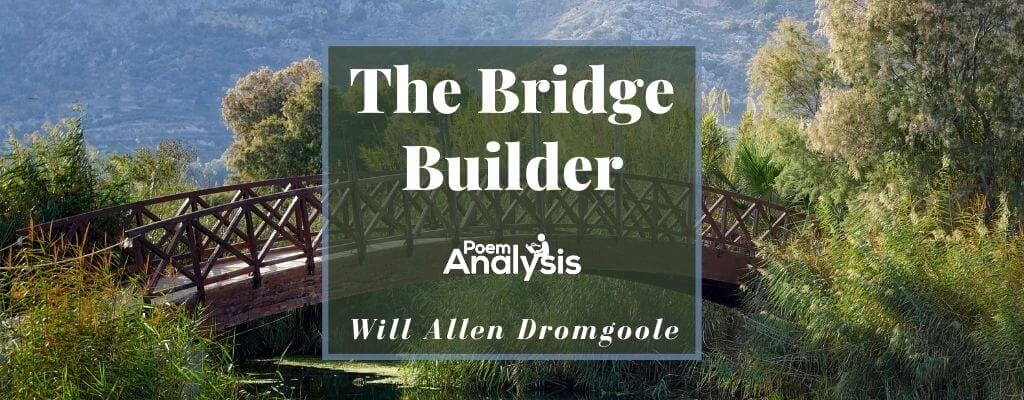Although its origins are not entirely clear, it is likely that ‘The Bridge Builder’ was first published in The Builder in 1900. Since its publication, it has become a fairly popular poem that is often quoted within fraternal organizations and used as a moral lesson. The main themes of this piece are hard work, perseverance, confidence, and generosity. Through the text, the poem promotes working for the future and for the betterment of those around you.
The Bridge Builder Will Allen DromgooleAn old man going a lone highway,Came, at the evening cold and gray,To a chasm vast and deep and wide.Through which was flowing a sullen tideThe old man crossed in the twilight dim,The sullen stream had no fear for him;But he turned when safe on the other sideAnd built a bridge to span the tide.“Old man,” said a fellow pilgrim near,“You are wasting your strength with building here;Your journey will end with the ending day,You never again will pass this way;You’ve crossed the chasm, deep and wide,Why build this bridge at evening tide?”The builder lifted his old gray head;“Good friend, in the path I have come,” he said,“There followed after me to-dayA youth whose feet must pass this way.This chasm that has been as naught to meTo that fair-haired youth may a pitfall be;He, too, must cross in the twilight dim;Good friend, I am building this bridge for him!”
Summary
‘The Bridge Builder’ by Will Allen Dromgoole is a simple poem with a clear moral message about caring for others when there is no obligation to do so.
The poem depicts an old man who, close to the end of his days, decides to spend his time building a bridge he does not need. He crosses over a chasm and then once safely to the other side, decides to build a bridge. This is a selfless choice that is noticed and questioned by a passerby. The old man explains that he’s building the bridge not for himself, as he won’t be using it, but for anyone who comes after him.
Structure
‘The Bridge Builder’ by Will Allen Dromgoole is a three-stanza poem that is made up of uneven sets of lines. The first stanza contains eight, the second: six, and the third eight again. The lines follow a simple and consistent rhyme scheme of AABBCCDD, and so on, changing end sounds from line to line. This pattern emphasizes the moralistic nature of the poem. They flow easily and carry the reader to the end of the poem, as a river would, smoothly and efficiently.
Poetic Techniques
Dromgoole makes use of several poetic techniques in ‘The Bridge Builder’. These include but are not limited to imagery, alliteration, and personification. The first, imagery, refers to the elements of a poem that engage a reader’s senses. Traditionally, the word “image” is related to visual sights, things that a reader can imagine seeing, but the imagery is much more than that. It is something one can sense with their five senses. For example, the “dim twilight” of the day and the old man’s “gray head”. These clear depictions help the reader feel as though they are part of the poem.
Alliteration occurs when words are used in succession, or at least appear close together, and begin with the same sound. For example, “built” and “bridge” in line eight of the first stanza and “followed” and “feet” in lines three and four of the third stanza.
Personification occurs when a poet imbues a non-human creature or object with human characteristics. For example, in the fourth line of the first stanza where the speaker describes the tide as “sullen,” and then in the sixth line as having “no fear for” the old man.
Analysis, Stanza by Stanza
Stanza One
An old man going a lone highway,
Came, at the evening cold and gray,
To a chasm vast and deep and wide.
Through which was flowing a sullen tide
The old man crossed in the twilight dim,
The sullen stream had no fear for him;
But he turned when safe on the other side
And built a bridge to span the tide.
In the first stanza of The Bridge Builder,’ the speaker begins by describing the progress of an old man. He was walking along a highway when he came to a “chasm,” or opening in the ground, that was “deep and wide”. There was no way to go easily around. The waters that flowed within it were “sullen” and the old man decided that he must do something about it.
It is this desire to help, to make the world a better place not just for oneself but for everyone else, that is at the heart of this poem. This theme is why the poem became, and has remained, as popular as it is. This first stanza contains examples of personification with the depiction of the stream as “sullen”.
Once the old man had traversed the waters and gotten to the other side, rather than leaving, he decided to stay and build a bridge.
Stanza Two
“Old man,” said a fellow pilgrim near,
“You are wasting your strength with building here;
Your journey will end with the ending day,
You never again will pass this way;
You’ve crossed the chasm, deep and wide,
Why build this bridge at evening tide?”
The second stanza, and the third, contain dialogue. In these first lines, the old man is spoken to by a pilgrim, another person who is traveling. He tells the man that he’s wasting his time. He does not have the same desire to help as the man does. This person is a better representative of the majority of those who would’ve crossed the waters.
The pilgrim says that the old man’s “journey will end with the ending day”. This is a roundabout way of saying that the old man is quite old and that he will “never again…pass this way”. Why the pilgrim is wondering, would he waste his time building this bridge that he’ll never use?
Stanza Three
The builder lifted his old gray head;
“Good friend, in the path I have come,” he said,
“There followed after me to-day
A youth whose feet must pass this way.
This chasm that has been as naught to me
To that fair-haired youth may a pitfall be;
He, too, must cross in the twilight dim;
Good friend, I am building this bridge for him!”
The third stanza of ‘The Bridge Builder’ contains the old man’s response. He is confident in his choice to remain there and build the bridge. He speaks about the future and about the youth that may come after him along this way. For the old man, the river was not an obstacle, but it might be for someone else. If he does not build it, he fears that someone will be injured. The old man makes it clear to this pilgrim, who he calls “Good friend” as a means of common greeting, that he is building the bridge for that future youth that he doesn’t know.
The poem ends there and a reader can only predict what happens next. Will the old man finish the bridge? But more importantly, what bridges, the poet is asking, can you the reader, build in your own life?




